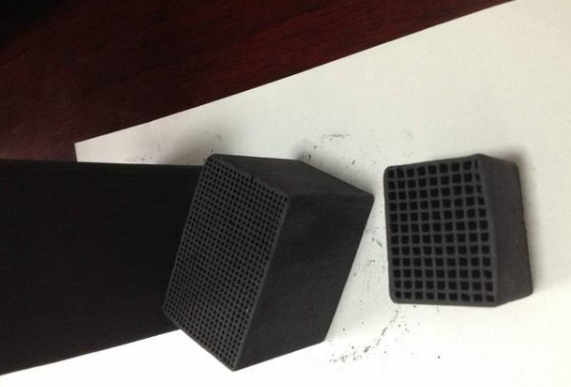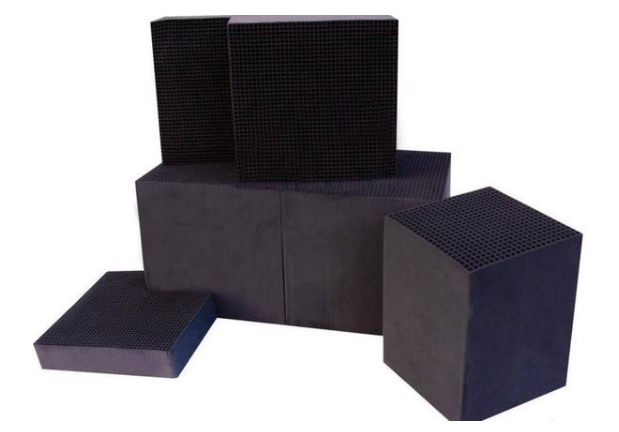Structure characteristics and application instructions of honeycomb activated carbon
Honeycomb activated carbon is widely used in air pollution control because of its large area, microporous structure, high adsorption capacity and high surface active carbon. The pollutants in the exhaust gas are absorbed and decomposed, so as to play a role in purification. The pollutants that can be removed by honeycomb activated carbon in different degrees are: nitrogen oxide, carbon tetrachloride, chlorine, benzene, formaldehyde, acetone, ethanol, ether, methanol, acetic acid, ethyl ester, styrene, phosgene, malodorous gas, etc. The modified honeycomb activated carbon impregnated with chemical reagent can remove acid mist, alkali mist, amine, mercaptan, sulfur dichloride, hydrogen sulfide, ammonia, mercury, carbon monochloride, dioxin, etc.

The use of honeycomb activated carbon shows that the best way to control air pollution is to use honeycomb activated carbon, which is composed of two absorbers in parallel, which can be used to deal with intermittent exhaust, and can be used for continuous exhaust. One of them is for adsorption, the other is for desorption regeneration, and the desorbed pollutants will be exhausted after catalytic combustion. The use of honeycomb activated carbon should avoid high temperature as far as possible, because high temperature will reduce the adsorption capacity, and the adsorption effect will decrease due to the rise of temperature. At the same time, avoid the high dust content in the gas, because the tar dust mist will block the pores of the activated carbon. In this case, it is necessary to install a dust filtering device in front of the honeycomb activated carbon to improve the efficiency and service life.

The main components of honeycomb activated carbon parameters: the normal compressive strength of activated carbon is greater than 0.8MPa, the commonly used specifications are 50 * 50 * 100mm, 100 * 100 * 100mm, the service temperature is less than 400 ℃, the hole density is 100 holes / square inch, the wind speed of 150 holes / square inch is 0.8m/s, the specific surface area is greater than 700m2 / g, the appearance of the product is flat, and there is no crack note: other specifications can be produced according to the user's requirements
It is widely used in various organic waste gas purification systems with low concentration and large air volume. When the treated waste gas passes through the square hole of honeycomb activated carbon, it can fully contact with the activated carbon with small wind resistance coefficient, and has excellent adsorption, desorption performance and gas dynamics performance. It can be widely used for purification and treatment of organic gases including toluene, xylene, benzene, etc., phenols, lipids, alcohols, aldehydes, odorous gases and various gases containing trace metals. The waste gas treatment and purification efficiency of the environmental protection equipment with honeycomb activated carbon is high, the adsorption bed volume is small, the equipment energy consumption is low, the cost and operation cost can be reduced, and the purified gas completely meets the requirements of environmental protection emissions.
Coconut shell activated carbon adsorption refers to the adsorption of one or more substances in water by using the solid surface of activated carbon to achieve the purpose of purifying water quality. Adsorption capacity and adsorption speed are the main indicators to measure the adsorption process. The size of adsorption capacity is measured by adsorption capacity. The adsorption speed refers to the mass free adsorbed by the adsorbent per unit weight in unit time. In water treatment, the adsorption speed determines the contact time between wastewater and adsorbent. Coconut shell activated carbon porous adsorbent, known as activated carbon, is basically an amorphous substance, which is composed of fine graphite like microcrystals and hydrocarbon parts that connect them together.
The iodine value of the activated carbon is more than 1000, the particle is even, the specific surface area is large, and the strong adsorption capacity is related to the water temperature and the quality of the water. The higher the water temperature is, the stronger the adsorption capacity of activated carbon will be; if the water temperature is above 30 ℃, the adsorption capacity will reach the limit, and it is possible to reduce gradually. When the water quality is acidic, the adsorption capacity of activated carbon to anionic substances is relatively weakened; when the water quality is alkaline, the adsorption capacity of activated carbon to cationic substances is weakened. Therefore, pH instability of water quality will also affect the adsorption capacity of activated carbon.





